If you’ve been exploring the world of low-carb eating, you’ve likely come across the ketogenic diet—or keto for short. The ketogenic diet has become a popular choice for people looking to lose weight, improve mental clarity, or boost their energy levels. But, if you’re new to keto, navigating what foods to eat (and avoid) can feel like a maze. No worries though—this guide will walk you through the essential foods for a successful keto journey and how to create balanced, satisfying meals.
What is the Keto Diet?
The ketogenic diet is a high-fat, moderate-protein, and low-carbohydrate eating plan that shifts your body’s energy source from carbohydrates (glucose) to fat (ketones). The goal is to reach a state of ketosis, where your body burns fat for fuel instead of sugar. This metabolic shift can help with weight loss, improved energy, and mental clarity.
To enter ketosis, you’ll typically aim to consume only about 5-10% of your daily calories from carbs. For most people, this is around 20–50 grams of net carbs per day.
Keto Foods: The Essentials
When following a ketogenic diet, the foods you choose should fit within these basic categories: high in healthy fats, moderate in protein, and very low in carbohydrates. Here’s a breakdown of the foods that should be your go-to:
1. Healthy Fats
Healthy fats are the cornerstone of the keto diet. They provide your body with the fuel it needs while keeping you full and satisfied.
- Avocados: Rich in heart-healthy monounsaturated fats and fiber, avocados are a keto dieter’s best friend. They’re versatile and can be added to salads, smoothies, or eaten on their own with a sprinkle of sea salt.
- Olive Oil: Olive oil is packed with monounsaturated fats and antioxidants. It’s perfect for drizzling on salads, roasting vegetables, or using in keto-friendly dressings.
- Coconut Oil: With its high content of medium-chain triglycerides (MCTs), coconut oil is easily converted into ketones. It’s ideal for cooking, baking, or adding to coffee for a keto-friendly boost.
- Nuts and Seeds: Almonds, macadamia nuts, chia seeds, and flaxseeds are nutrient-dense and high in fats while being low in carbs. They’re great for snacking, but be careful of portion sizes, as they are calorie-dense.

2. Protein (Moderate)
Protein intake on the keto diet is moderate—not too high and not too low. Too much protein can kick you out of ketosis by converting excess protein into glucose through a process called gluconeogenesis.
- Meat and Fatty Cuts: Grass-fed beef, pork, and lamb are excellent choices. Fatty cuts like ribeye or pork belly are particularly beneficial since they provide ample fats to support ketosis.
- Poultry: Chicken, turkey, and duck are good protein options. Skin-on chicken and dark meat tend to be higher in fat.
- Fish and Shellfish: Fatty fish like salmon, sardines, and mackerel are rich in omega-3 fatty acids, which are important for heart health and reducing inflammation.
- Eggs: Eggs are a keto staple because they are high in protein, healthy fats, and low in carbs. Plus, they’re incredibly versatile and easy to cook.

3. Low-Carb Vegetables
Keto-friendly vegetables are typically non-starchy, high in fiber, and packed with vitamins and minerals. These vegetables should make up the bulk of your carb intake.
- Leafy Greens: Spinach, kale, arugula, and other leafy greens are incredibly low in carbs and high in fiber. They’re great for salads, sautéing, or blending into smoothies.
- Cruciferous Vegetables: Broccoli, cauliflower, Brussels sprouts, and cabbage are all low in carbs but rich in fiber, making them perfect for keto meals.
- Zucchini: Zucchini is low in carbs and can be used as a pasta substitute, spiralized into “zoodles,” or added to stir-fries and casseroles.
- Avocados (again!): Not only are avocados high in fat, but they’re also a great source of fiber and very low in carbohydrates.
4. Cheese and Dairy
Cheese and full-fat dairy are allowed on keto, but again, moderation is key. Stick with full-fat options to maximize fat intake without overdoing the protein.
- Cheese: Hard cheeses like cheddar, gouda, and parmesan are low in carbs and high in fat. Soft cheeses like cream cheese and goat cheese are also great options.
- Butter and Ghee: Butter is a keto staple, and ghee (clarified butter) is a great alternative since it’s free from milk solids and lactose. Both are perfect for cooking or adding to vegetables and meats.
- Heavy Cream: Heavy cream is high in fat and low in carbs, making it ideal for adding richness to sauces, coffee, or desserts.
5. Berries (in moderation)
While most fruits are too high in sugar and carbs to be included in a keto diet, berries are an exception. They’re lower in sugar and can be consumed in small quantities.
- Strawberries, blackberries, raspberries, and blueberries all make excellent options for a sweet snack or topping for keto desserts like chia pudding or keto cheesecake.
6. Beverages
On the keto diet, choosing the right beverages is important, as many drinks contain hidden sugars and carbs.
- Water: Always the best choice! Aim to drink plenty of water throughout the day to stay hydrated, especially since your body excretes more water on a low-carb diet.
- Coffee: Black coffee or coffee with a splash of heavy cream is a keto-friendly drink. You can also enjoy bulletproof coffee (coffee with butter and MCT oil) for a more substantial energy boost.
- Tea: Unsweetened herbal, green, or black tea is perfect for keto. Avoid sweetened teas or fruit-based teas that contain added sugars.
- Bone Broth: Not only is bone broth low in carbs, but it’s also packed with collagen, which is great for skin, joints, and gut health.

Foods to Avoid on Keto
To stay in ketosis, you’ll want to avoid high-carb foods, including:
- Sugary foods: Candy, cakes, pastries, ice cream, and most sugary snacks are loaded with carbs.
- Grains and Starches: Bread, pasta, rice, and cereals are high in carbs and should be avoided.
- Most Fruits: While berries are okay in moderation, other fruits like bananas, apples, and grapes are too high in sugar for the keto diet.
- Legumes: Beans, lentils, and peas are healthy but too carb-heavy for a keto diet.
- Low-fat Dairy: Low-fat and fat-free dairy products often have added sugars and carbs.
Sample Keto Meal Ideas
- Breakfast: Scrambled eggs with spinach, avocado, and a side of bacon.
- Lunch: Grilled chicken salad with mixed greens, olive oil dressing, and a sprinkle of cheese.
- Dinner: Pan-seared salmon with roasted Brussels sprouts and a creamy garlic butter sauce.
- Snack: A handful of almonds or a few slices of cheese with olives.
Conclusion
The ketogenic diet may seem restrictive at first, but with the right foods, it can become a sustainable, enjoyable lifestyle. By focusing on high-fat, moderate-protein, and low-carb options, you can enjoy a wide variety of delicious meals that help you stay in ketosis. From creamy avocados to crispy bacon and fresh leafy greens, the possibilities are endless. And most importantly, the foods you eat on keto can support weight loss, better energy, and improved mental clarity.
With a little planning and creativity, you’ll soon find yourself thriving on the keto diet!




